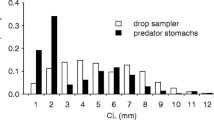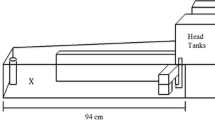Abstract
We studied size-structured predator-prey interactions between blue crabs (Callinectes sapidus) and marsh periwinkles (Littoraria irrorata) with a combination of field studies, laboratory experiments and individual-based modeling. Size distributions of Littoraria differed among years at the same sites in a salt marsh and could largely be explained by dominance of strong cohorts in the population. At a given site, abundance increased with elevation above tidal datum. Size-selective predation by blue crabs does not appear to be an important regulator of snail size distributions but may have a major effect on local abundance. Laboratory studies indicated that predator-prey interactions between Callinectes and Littoraria are strongly size-dependent. Crabs were generally effective at feeding on periwinkles at size ratios greater than approximately 6 (crab width: snail length). At lower size ratios crabs were far less effective at manipulating the snails, which often survived but with damaged shells. An individual-based model which incorporated information about incidence of snail shell scarring (resulting from non-lethal interactions) and snail density, predicted reduced predation rates and smaller average crab size with distance from the low tide refugium for crabs.
Similar content being viewed by others
References
Adams DA (1963) Factors influencing vascular plant zonation in North Carolina salt marshes. Ecology 44:445–456
Appleton RD, Palmer AR (1988) Water-borne stimuli released by predatory crabs and damaged prey induce more predator-resistant shells in a marine gastropod. Proc Nat Acad Sci USA. 85:4387–4391
Arnold WS, Kneib RT (1983) The size distribution of blue crabs (Callinectes sapidus Rathbun) along a tidal gradient in a Georgia salt marsh. Ga J Sci 41:93 [Abstr]
Bingham FO (1972) Several aspects of the reproductive biology of Littorina irrorata (Gastropoda). The Nautilus 86:8–10
Byrlinsky M (1972) Steady-state sensitivity analysis of energy flow in a marine ecosystem. In: Patten BV (ed) Systems analysis and simulation in ecology. Vol. II. Academic Press, New York, NY pp 81–101
Connell JH (1970) A predator-prey system in the marine inter tidal region. I. Balanus glandula and several predatory species of Thais. Ecol Monogr 40:49–78
DeAngelis DL, Gross LJ (eds) (1992) Individual — based models and approaches in ecology: populations, communities and ecosystems. Chapman and Hall, New York, NY. pp 525
Eggleston DB (1990) Behavioral mechanisms underlying variable functional responses of blue crabs, Callinectes sapidus feeding on juvenile oysters, Crassostrea virginica. J Anim Ecol 59:615–630
Frey RW, Basan PB (1985) Coastal salt marshes. In: Coastal Sedimentary Environments, Springer Berlin Heidelberg New York, pp 225–301
Grosberg RK (1981) Competitive ability influences habitat choice in marine invertebrates. Nature 290:700–702
Hamilton PV (1976) Predation on Littorina irrorata (Mollusca: Gastropoda) by Callinectes sapidus (Crustacea: Portunidae). Bull Mar Sci 26:403–409
Hamilton PV (1978) Intertidal distribution and long-term movements of Littorina irrorata (Mollusca: Gastropoda). Mar Biol 46:49–58
Huston MA, DeAngelis DL, Post WM (1988) New computer models unify ecological theory. BioScience 38:682–691
Juanes F (1992) Why do decapod crustaceans prefer small-sized molluscan prey? Mar Ecol Prog Ser 87:239–249
Kitchell JF, Carpenter SR (1987) Piscivores, planktivores, fossils, and phorbins. In: Kerfoot CW, Sih A (eds) Predation: direct and indirect impacts on aquatic communities. University Press of New England, NH. pp 132–146
Kitchell JA, Boggs CH, Kitchell JF, Rice JA (1981) Prey selection by naticid gastropods: experimental tests and application to the fossil record. Paleobiology 7:533–552
Kneib RT (1984) Patterns of invertebrate distribution and abundance in the intertidal salt marsh: causes and questions. Estuaries 7:392–412
Kneib RT (1991) Indirect effects in experimental studies of marine soft-sediment communities. Am Zool 31:874–885
Kneib RT, Weeks CA (1990) Intertidal distribution and feeding habit of the mud crab (Erythium limosum). Estuaries 13:464–468
Menge BA, Sutherland JP (1976) Species diversity gradients: synthesis of the roles of predation, competition, and temporal heterogeneity. Am Nat 110:351–369
Montague CL, Bunker SM, Haines EB, Pace ML, Wetzel RL (1981) Aquatic macroconsumers. In: Pomeroy LR, Wiegert RG (eds) The ecology of a salt marsh. Ecological Studies No. 38. Springer Berlin Heidelberg New York, pp 69–85
Moore HB (1937) The biology of Littorina littorea I. Growth of the shell and tissues, spawning, length of life and mortality. J Mar Biol Assoc UK 21:721–742
Newell GE (1958) The behaviour of Littorina irrorata under natural conditions and its relation to position on the shore. J Mar Biol Assoc UK 37:229–239
Paine RT (1966) Food web complexity and species diversity. Am Nat 100:65–75
Paine RT (1974) Intertidal community structure. Experimental studies on the relationship between a dominant competitor and its principal predator. Oecologia 15:93–120
Peterson CH (1990) On the role of ecological experimentation in resource management: managing fisheries through mechanistic understanding of predator feeding behavior. In: Hughes RN (ed) Behavioral mechanisms of food selection, Springer Berlin Heidelberg New York, pp 821–846
Peterson CH (1991) Intertidal zonation of marine invertebrates in sand and mud. Am Sci 79:236–249
Pomeroy LR, Wiegert RG (eds) (1981) The Ecology of a Salt Marsh. Ecological Studies No. 38. Springer Berlin Heidelberg New York, pp 271
Posey MH, Hines AH (1991) Complex predator-prey interactions within an estuarine benthic community. Ecology 72:2155–2169
Sousa WP (1993) Size-dependent predation on the salt-marsh snail Cerithidea californica Haldeman. J Exp Mar Biol Ecol 166:19–37
Stanhope HS, Banta WC, Temkin MT (1982) Size-specific emergence of the marsh snail, Littorina irrorata: effect of predation by blue crabs in a Virginia salt marsh. Gulf Res Rep 7:179–182
Stiven AE, Hunter JT (1976) Growth and mortality of Littorina irrorata in three North Carolina marshes. Chesapeake Sci 17:168–176
Vermeij GJ (1972) Intraspecific shore-level size gradients in intertidal molluscs. Ecology 53:693–700
Vermeij GJ (1982a) Environmental change and the evolutionary history of the periwinkle (Littorina littorea) in North America. Evolution 36:561–580
Vermeij GJ (1982b) Gastropod shell form, repair and breakage in relation to predation by the crab Callapa. Malacogia 23:1–12
Warren JH (1985) Climbing as an avoidance behavior in the salt-marsh periwinkle, Littorina irrorata (Say). J Exp Mar Biol Ecol 89:11–28
West DL, Williams AH (1986) Predation by Callinectes sapidus (Rathbun) within Spartina alterniflora (Loisel) marshes. J Exp Mar Biol Ecol 100:75–95
Wilkinson L (1989) SYSTAT: The system for statistics. Evanson, IL: SYSTAT, Inc.
Willason SW (1981) Factors influencing the distribution and coexistence of Pachygrapsus crassipes and Hemigrapsus oregonensis (Decapoda: Grapsidae) in a California salt marsh. Mar Biol 64:125–133
Author information
Authors and Affiliations
Rights and permissions
About this article
Cite this article
Schindler, D.E., Johnson, B.M., MacKay, N.A. et al. Crab: snail size-structured interactions and salt marsh predation gradients. Oecologia 97, 49–61 (1994). https://doi.org/10.1007/BF00317908
Received:
Accepted:
Issue Date:
DOI: https://doi.org/10.1007/BF00317908




